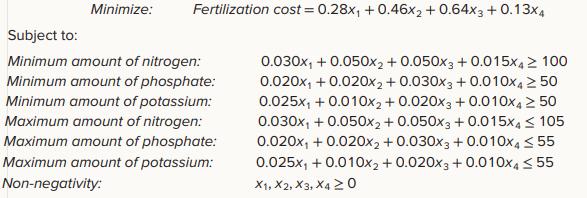Demand for organic food has grown steadily over the years. Organic strawberry farming is one of the
Question:
Demand for organic food has grown steadily over the years. Organic strawberry farming is one of the segments in the food and agriculture industry that is projected to continue expanding in the foreseeable future. Estuary Organic, a fruit farming company on the coast of California, struggles to reduce its production cost while staying true to its mission of offering fully certified organic produce to its customers.
To address the cost issue, Estuary Organic hires Professor Tom Richards as a consultant to review different types of organic fertilizers that the company has used. His task is to find a combination of organic fertilizers that can meet the three primary nutrient requirements in the soil, nitrogen (N), phosphate (P2O5), and potassium (K2O). At the same time, Professor Richards needs to take into consideration the cost of certified organic fertilizers in his analysis.
For each strawberry planting season, growers need to have the right combination of nitrogen, phosphate, and potassium in the soil. Adding too much or too little of these nutrients is detrimental to the plant growth and its ability to bear fruit. This combination of N, P2O5, and K2O nutrients is often called the NPK value. Generally, the minimum amount of NPK per acre is 100 lbs, 50 lbs, and 50 lbs, respectively.
Based on the current soil condition and soil testing results, Professor Richards also determines that the maximum amount of NPK per acre is 125 lbs, 55 lbs, and 55 lbs, respectively. Some of the fertilizers commonly used in the local area and by Estuary Organic include alfalfa meal (typically made from fermented alfalfa), soybean meal, fish meal (typically pollock, mackerel, and/or anchovies), and compost made from animal manure. The cost and NPK composition of each fertilizer is listed in Table 13.4
TABLE 13.4 Organic Fertilizers, Their Cost, and Nutrient Content

The goal of this consulting engagement is to provide Estuary Organic a recommended combination of fertilizers that meet the NPK requirements at a minimal cost. After analyzing relevant information, Professor Richards submits the following report to the Estuary Organic owner.
In this report, we consider the cost and NPK information provided by Estuary Organic Farm and develop an optimization model that represents the relationship among the cost and NPK values of each type of organic fertilizer as well as the NPK requirements for each acre of land. We use a linear programming technique and develop the following formulation.

The four decision variables, x1, x2, x3, and x4, represent the amount of alfalfa meal, soybean meal, fish meal, and compost (in pounds) to be mixed into the fertilizer compound. We also convert the cost of each fertilizer into a per-pound basis (e.g., $0.28 per pound for the alfalfa meal, $0.46 per pound for the soybean meal, and so on). The cost-per-pound values are used as the objective function coefficients. Based on the results obtained from the linear programming formulation, we recommend the mix of organic fertilizers for each acre of land as shown in Table 13.5.
TABLE 13.5 Recommended Mix of Fertilizers per Acre 
The optimal combination provides 100 pounds of nitrogen, 55 pounds of phosphate, and 50 pounds of potassium per acre. The base for the fertilizer compound is the animal manure compost, which is the most inexpensive fertilizer but has the least NPK values among the four fertilizer choices. We then supplement the compost with alfalfa and soybean meals to reach the required amount of nitrogen and potassium. Because we do not use any fish meal, the most expensive of the four fertilizers, in the recommended fertilizer mix, we are able to keep the cost per acre to a minimal amount of $905.
We also examine the impact of possible changes in the cost of fertilizers. For example, if the cost of animal compost increases from $6.50 to $7.00 per 50 pounds, we will have to reformulate our fertilizer mix. In such a scenario, one possible option is to use only alfalfa and soybean meals to achieve the NPK requirements while keeping the cost reasonably low. Based on our initial analysis, we would recommend using 1,578.95 pounds of alfalfa meal and 1,052.63 pounds of soybean meal, which will result in a total cost of $926.31 per acre.
Another scenario that we consider in our analysis is if the cost of alfalfa meal drops from $14 to $13 per 50 pounds (while the cost of compost remains at $6.50 per 50 pounds). With its well-balanced NPK value, we could use a much higher amount of alfalfa meal while keeping the total cost low. Specifically, one possible fertilizer mix in this scenario would be to use 1,750 pounds of alfalfa meal, 875 pounds of soybean meal, and only 250 pounds of animal manure compost. This would result in a total cost of $890 per acre.
Step by Step Answer:

Business Analytics Communicating With Numbers
ISBN: 9781260785005
1st Edition
Authors: Sanjiv Jaggia, Alison Kelly, Kevin Lertwachara, Leida Chen





